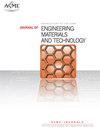高周疲劳蠕变联合寿命预测模型的建立
IF 1.9
4区 材料科学
Q3 ENGINEERING, MECHANICAL
Journal of Engineering Materials and Technology-transactions of The Asme
Pub Date : 2022-06-28
DOI:10.1115/1.4054889
引用次数: 0
摘要
虽然工业燃气轮机叶片通常设计为抗蠕变和高周疲劳(HCF)失效,但很少考虑这两种载荷条件的组合。在HCF加载之前或同时引起的蠕变损伤的影响尚未得到很好的确定,并且可以显着降低这些关键部件的HCF寿命。在设计高负荷的下一代工业燃气轮机叶片时,需要一个能够捕捉这些叠加效应的综合寿命预测模型,以确保保持当前的可靠性标准。本研究对高温镍基合金的HCF和蠕变载荷对其寿命的影响进行了表征和建模。模型的组成和校准是使用在750°C和850°C下对未加工和预蠕变试样进行的HCF试验数据进行的。实验数据包括广泛的应力比和预蠕变应变,以模拟潜在的涡轮叶片加载条件。所提出的微观结构知情模型基于现有原理,并依赖于从测试样品的全面失效分析中收集的测试数据和信息。本文章由计算机程序翻译,如有差异,请以英文原文为准。
Creation of a Life Prediction Model for Combined High-Cycle Fatigue and Creep
While industrial gas turbine blades are commonly designed to resist creep and high-cycle fatigue (HCF) failure, the combination of these two loading conditions is seldom considered. The effect of creep damage elicited prior or concurrent to HCF loading is not well established and can significantly reduce the HCF lifetime of these critical components. A comprehensive life prediction model capable of capturing these superimposed effects is needed to ensure current reliability standards are maintained when designing aggressively-loaded, next-generation industrial gas turbine blades. The consequence of combined HCF and creep loading to the lifetime a Ni-base superalloy is characterized and modeled in this study. Composition and calibration of the model is carried out using data from HCF tests conducted on virgin and pre-crept specimens at 750°C and 850°C. The experimental data encompasses a wide range of stress ratios and pre-creep strains to mimic to the expansive set of potential turbine blade loading conditions The proposed microstructurally-informed model is based on existing principles and relies on test data and information gathered from a comprehensive failure analysis of the tested samples.
求助全文
通过发布文献求助,成功后即可免费获取论文全文。
去求助
来源期刊
CiteScore
3.00
自引率
0.00%
发文量
30
审稿时长
4.5 months
期刊介绍:
Multiscale characterization, modeling, and experiments; High-temperature creep, fatigue, and fracture; Elastic-plastic behavior; Environmental effects on material response, constitutive relations, materials processing, and microstructure mechanical property relationships

 求助内容:
求助内容: 应助结果提醒方式:
应助结果提醒方式:


